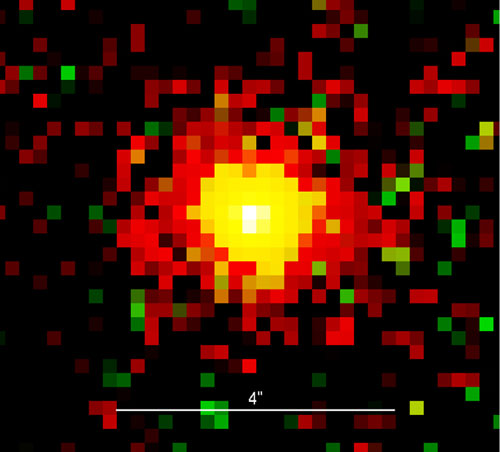Most Distant Galaxy With Big Black Hole Discovered

The most distant known galaxy to host a supermassive blackhole has been discovered in a galaxy that formed in the early history of theuniverse.
The galaxy, as large as the Milky Way, is about 12.8 billionlight-years away and harbors a supermassive black hole that contains at least abillion times as much matter as our sun. The universe is about 13.7 billionyears old, and faraway objects like this are seen asthey existed near the dawn of time, their light just now arriving at Earth.
The find, to be detailed in the journal Monthly Notices ofthe Royal Astronomical Society later this month, was unexpected:
"It is surprising that such a giant galaxy existed whenthe universe was only one-sixteenth of its present age, and that it hosted ablack hole one billion times more massive than the sun. The galaxy and blackhole must have formed very rapidly in the early universe," said TomotsuguGoto of the University of Hawaii and part of the team that made the discovery.
The previous record holder for most distant host galaxy,found in 2005, was located at 12.5 billion light-years away, making the newfinding "a significant jump," Goto told SPACE.com.
The most distant known black hole itself sits on the cusp ofthe 13 billion light-year mark, and was discovered in 2007. In June of thisyear, astronomers announced another black hole benchmark of the mostmassive black hole known.
Astronomers can't see black holes, but they presume theirpresence by noting the mass that circles around them and calculating thegravity that must be at play. Gathering information about host galaxies ofsupermassive black holes is important in order to understand the long-standingmystery of how galaxies and black holes have evolved together.
Get the Space.com Newsletter
Breaking space news, the latest updates on rocket launches, skywatching events and more!
Until now, studying host galaxies in the distant Universehas been extremely difficult because the blinding bright light from the vicinityof the blackhole (generated by all the matter it hungrilysucks in) makes it more difficult to see the already faint light from thehost galaxy.
"We have witnessed a supermassive black hole and itshost galaxy forming together. This discovery has opened a new window forinvestigating galaxy-black hole co-evolution at the dawn of the Universe,"said team member Yousuke Utsumi of the National Astronomical Observatory ofJapan.
Unlike smaller black holes, which are known to form when alarge star dies, the origin of the supermassive black holes remains a mystery.One current suggestion is that these whoppers form when several intermediateblack holes merge. The host galaxy discovered in this work provides a reservoirof such intermediate black holes.
To see the supermassive black hole, the team of scientistsused new red-sensitive Charge Coupled Devices (CCDs) installed in theSuprime-Cam camera on the Subaru telescope on Mauna Kea.
- Video ? Slow Birth of a Black Hole
- Video ? Black Holes: Warpers of Space and Time
- A Real Whopper: Black Hole Is Most Massive Known
Join our Space Forums to keep talking space on the latest missions, night sky and more! And if you have a news tip, correction or comment, let us know at: community@space.com.

Andrea Thompson is an associate editor at Scientific American, where she covers sustainability, energy and the environment. Prior to that, she was a senior writer covering climate science at Climate Central and a reporter and editor at Live Science, where she primarily covered Earth science and the environment. She holds a graduate degree in science health and environmental reporting from New York University, as well as a bachelor of science and and masters of science in atmospheric chemistry from the Georgia Institute of Technology.









